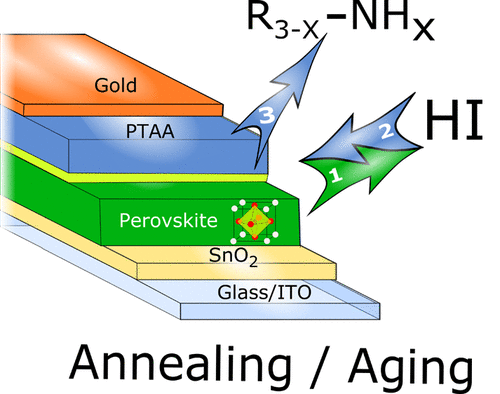当前位置:
X-MOL 学术
›
ACS Appl. Energy Mater.
›
论文详情
Our official English website, www.x-mol.net, welcomes your
feedback! (Note: you will need to create a separate account there.)
Effect of the Hole Transporting/Active Layer Interface on the Perovskite Solar Cell Stability
ACS Applied Energy Materials ( IF 5.4 ) Pub Date : 2020-03-10 00:00:00 , DOI: 10.1021/acsaem.9b02281 Manon Spalla 1, 2 , Lara Perrin 1 , Emilie Planes 1 , Muriel Matheron 2 , Solenn Berson 2 , Lionel Flandin 1
ACS Applied Energy Materials ( IF 5.4 ) Pub Date : 2020-03-10 00:00:00 , DOI: 10.1021/acsaem.9b02281 Manon Spalla 1, 2 , Lara Perrin 1 , Emilie Planes 1 , Muriel Matheron 2 , Solenn Berson 2 , Lionel Flandin 1
Affiliation

|
In the field of photovoltaics, perovskite solar cells have attracted great interest due to their high efficiency combined with a strong potential for low cost and good versatility. One of the main issues concerns the intrinsic stability of these cells. To develop mitigation strategies, there is a critical need for a better understanding of the most plausible degradation mechanisms. This work focuses on the impact of the hole transporting layer (HTL) on the stability of planar NIP perovskite solar cells based on MAPbI3-xClx. From the comparison of two different HTLs (P3HT and PTAA), the crucial role of interfacial materials on the stability of a complete device is demonstrated. Even if PTAA-based devices presented better performances in the initial state, their degradation under mild aging conditions (35 °C, under dark and inert conditions) is more pronounced than that with the P3HT counterpart. Thanks to complementary characterization tools (infrared spectroscopy, X-ray diffraction, UV–visible absorption, and photoluminescence) applied to different stages of the stack assembly (with respectively three, four, or five layers), a degradation mechanism was identified at the perovskite–PTAA interface. These devices consist of several extremely thin layers; the interfaces play an important role on the performances and stability of the complete cells. It is a pioneering work in the community, which could be transposed to other devices and architectures.
中文翻译:

空穴传输/活性层界面对钙钛矿太阳能电池稳定性的影响
在光伏领域,钙钛矿太阳能电池因其高效率以及低成本和多功能性的强大潜力而备受关注。主要问题之一涉及这些细胞的固有稳定性。为了制定缓解策略,迫切需要更好地了解最合理的降解机制。这项工作着眼于空穴传输层(HTL)对基于MAPbI 3-x Cl x的平面NIP钙钛矿太阳能电池稳定性的影响。。通过比较两个不同的HTL(P3HT和PTAA),证明了界面材料对完整设备的稳定性的关键作用。即使基于PTAA的设备在初始状态下表现出更好的性能,它们在温和的老化条件下(35°C,在黑暗和惰性条件下)的降解也比P3HT同类产品更为明显。由于将互补的表征工具(红外光谱,X射线衍射,UV可见吸收和光致发光)应用于堆叠组件的不同阶段(分别具有三层,四层或五层),因此在钙钛矿上发现了降解机理。 –PTAA接口。这些设备由几个极薄的层组成。接口对整个电池的性能和稳定性起着重要作用。
更新日期:2020-03-10
中文翻译:

空穴传输/活性层界面对钙钛矿太阳能电池稳定性的影响
在光伏领域,钙钛矿太阳能电池因其高效率以及低成本和多功能性的强大潜力而备受关注。主要问题之一涉及这些细胞的固有稳定性。为了制定缓解策略,迫切需要更好地了解最合理的降解机制。这项工作着眼于空穴传输层(HTL)对基于MAPbI 3-x Cl x的平面NIP钙钛矿太阳能电池稳定性的影响。。通过比较两个不同的HTL(P3HT和PTAA),证明了界面材料对完整设备的稳定性的关键作用。即使基于PTAA的设备在初始状态下表现出更好的性能,它们在温和的老化条件下(35°C,在黑暗和惰性条件下)的降解也比P3HT同类产品更为明显。由于将互补的表征工具(红外光谱,X射线衍射,UV可见吸收和光致发光)应用于堆叠组件的不同阶段(分别具有三层,四层或五层),因此在钙钛矿上发现了降解机理。 –PTAA接口。这些设备由几个极薄的层组成。接口对整个电池的性能和稳定性起着重要作用。











































 京公网安备 11010802027423号
京公网安备 11010802027423号